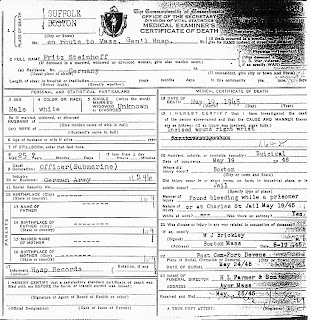Suicide: U-Boat 873 Commander Friedrich Steinhoff
Suicide (from Latin sui caedere, to kill oneself) is the act of intentionally ending one's own life. It is considered a sin in many religions, and a crime in some jurisdictions. On the other hand, to some individuals it is viewed as an honorable way to exit certain shameful or hopeless situations. To be considered suicide, the death must be a central component and intention of the act, not just a certain consequence.
 |
| Steinhoff after surrender |
 |
| U Boat 873 |
 |
| Steinhoff |
The obsessive coverage by newspapers, television, cable, bloggers and online news of high profile suicides eventually becomes old news when media attention focuses on the next news breaking story. But in its wake there is a treasure trove of historical documentation for future reporters and historians to discover patterns, similarities and hopefully, prevention of suicidal behavior.
It is presumed that Steinhoff was angry and embarrassed by his surrender and imprisonment. In hindsight, it is apparent that he may have viewed suicide as an honorable way to exit a shameful or hopeless situation.
Steinhoff, after several hours of interrogation, was found dead in his cell. Extant photographs of his capture reveals a man stoic and devoid of emotion. Transcripts of his interrogation describe him as arrogant and menacing. It was reported that Steinhoff, 35, committed suicide by breaking his eye glass spectacles and using a jagged piece of lens to sever the artery in one of his wrists. The doctor from U-873, Dr. Karl Steinke, tried to give first aid, but it was too late.
Steinhoff entered the German Navy in 1934 after having previously served in the Merchant Marine. His wartime experience consisted of duty on mine sweepers in Norwegian waters and two U-boat patrols. The U-873 was commissioned on 1 March 1944 and left on its first patrol on 17 February 1945. On 7 May 1945, while on course for operation patrol in the Caribbean, Steinhoff and his crew received news of Germany’s capitulation ending the war.
 |
| Steinhoff and crew after surrender |
Steinhoff surrendered his ship and crew on 11 May 1945, and was escorted to the Navy Yard at Portsmouth, New Hampshire, arriving on 16 May 1945. The following day, the captain and his crew were taken Suffolk County Charles Street Jail in Boston for interrogation and disposition to POW camps. A journalist described the arrival of the prisoners reporting, “The crew was marched in handcuffs through the streets of Boston where they pelted with insults and garbage.”
 |
| Steinhoff after surrender |
Soon after Steinhoff’s suicide there were rumors that his death may have been an end result of the interrogation methods employed by the military. In particular, one rumor was that when Steinhoff was returned to his cell after his interrogation his face was visibly swollen and bleeding.
Military sources at the time believed that Steinhoff possessed information of primal importance regarding a German plan to launch V-1 missiles from the decks of submarines, and whether Germany may have shared this technology with Japan, with who the United States was still at war. Military officials defended the interrogation tactics as based on “well-known psychological principles.” The interrogator admitted that he ordered a marine guard to slap Steinhoff, whom he described as, “a man of considerable physical proportions, threatening in his attitude and insolent in his demeanor, as well as extremely menacing and hysterically arrogant.” However, to some the rumors surrounding Steinhoff’s death indicated a treatment that contradicted the official statement.
 |
| Steinhoff death certificate |
 |
| Buried Fort Devens, Massaschusetts USA |
The suicides of Steinhoff certainly meets the defining criteria for suicide. But unfortunately, suicide is poignant reminder of the truth that countless numbers of human beings have and will consider suicide as an honorable means to exit certain shameful and hopeless situations.
 |
| U -873 Portsmouth Dry Dock |











